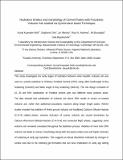| dc.contributor.author | Ilavsky, Jan | |
| dc.contributor.author | Andrews, Ross N | |
| dc.contributor.author | Bumajdad, Ali | |
| dc.contributor.author | Büyüköztürk, Oral | |
| dc.contributor.author | Andrews, Ross N. | |
| dc.contributor.author | Kupwade Patil, Kunal | |
| dc.contributor.author | Chin, Stephanie H. | |
| dc.date.accessioned | 2017-12-01T18:04:07Z | |
| dc.date.available | 2018-08-05T05:00:07Z | |
| dc.date.issued | 2017-10 | |
| dc.date.submitted | 2017-08 | |
| dc.identifier.issn | 0022-2461 | |
| dc.identifier.issn | 1573-4803 | |
| dc.identifier.uri | http://hdl.handle.net/1721.1/112342 | |
| dc.description.abstract | This study investigates the early ages of hydration behavior when basaltic volcanic ash was used as a partial substitute to ordinary Portland cement using ultra-small-angle X-ray scattering and wide-angle X-ray scattering (WAXS). The mix design consisted of 10, 30 and 50% substitution of Portland cement with two different-sized volcanic ashes. The data showed that substitution of volcanic ash above 30% results in excess unreacted volcanic ash, rather than additional pozzolanic reactions along longer length scales. WAXS studies revealed that addition of finely ground volcanic ash facilitated calcium-silicate-hydrate related phases, whereas inclusion of coarser volcanic ash caused domination by calcium-aluminum-silicate-hydrate and unreacted MgO phases, suggesting some volcanic ash remained unreacted throughout the hydration process. Addition of more than 30% volcanic ash leads to coarser morphology along with decreased surface area and higher intensity of scattering at early-age hydration. This suggests an abrupt dissolution indicated by changes in surface area due to the retarding gel formation that can have implication on early-age setting influencing the mechanical properties of the resulting cementitious matrix. The findings from this work show that the concentration of volcanic ash influences the specific surface area and morphology of hydration products during the early age of hydration. Hence, natural pozzolanic volcanic ashes can be a viable substitute to Portland cement by providing environmental benefits in terms of lower-carbon footprint along with long-term durability. | en_US |
| dc.publisher | Springer-Verlag | en_US |
| dc.relation.isversionof | http://dx.doi.org/10.1007/s10853-017-1659-4 | en_US |
| dc.rights | Creative Commons Attribution-Noncommercial-Share Alike | en_US |
| dc.rights.uri | http://creativecommons.org/licenses/by-nc-sa/4.0/ | en_US |
| dc.source | Springer US | en_US |
| dc.title | Hydration kinetics and morphology of Cement Pastes with Pozzolanic Volcanic Ash studied via Synchrotron based Techniques | en_US |
| dc.type | Article | en_US |
| dc.identifier.citation | Kupwade-Patil, Kunal, Stephanie Chin, Jan Ilavsky, Ross N. Andrews, Ali Bumajdad, and Oral Büyüköztürk. “Hydration Kinetics and Morphology of Cement Pastes with Pozzolanic Volcanic Ash Studied via Synchrotron-Based Techniques.” Journal of Materials Science 53, no. 3 (October 13, 2017): 1743–1757. | en_US |
| dc.contributor.department | Massachusetts Institute of Technology. Department of Civil and Environmental Engineering. Laboratory for Infrastructure Science and Sustainability | en_US |
| dc.contributor.department | Massachusetts Institute of Technology. Department of Civil and Environmental Engineering | en_US |
| dc.contributor.mitauthor | Kupwade Patil, Kunal | |
| dc.contributor.mitauthor | Chin, Stephanie H. | |
| dc.relation.journal | Journal of Materials Science | en_US |
| dc.eprint.version | Author's final manuscript | en_US |
| dc.type.uri | http://purl.org/eprint/type/JournalArticle | en_US |
| eprint.status | http://purl.org/eprint/status/PeerReviewed | en_US |
| dc.date.updated | 2017-11-14T05:49:23Z | |
| dc.language.rfc3066 | en | |
| dc.rights.holder | Springer Science+Business Media, LLC | |
| dspace.orderedauthors | Kupwade-Patil, Kunal; Chin, Stephanie; Ilavsky, Jan; Andrews, Ross N.; Bumajdad, Ali; Büyüköztürk, Oral | en_US |
| dspace.embargo.terms | N | en |
| mit.license | OPEN_ACCESS_POLICY | en_US |
| mit.metadata.status | Complete | |
